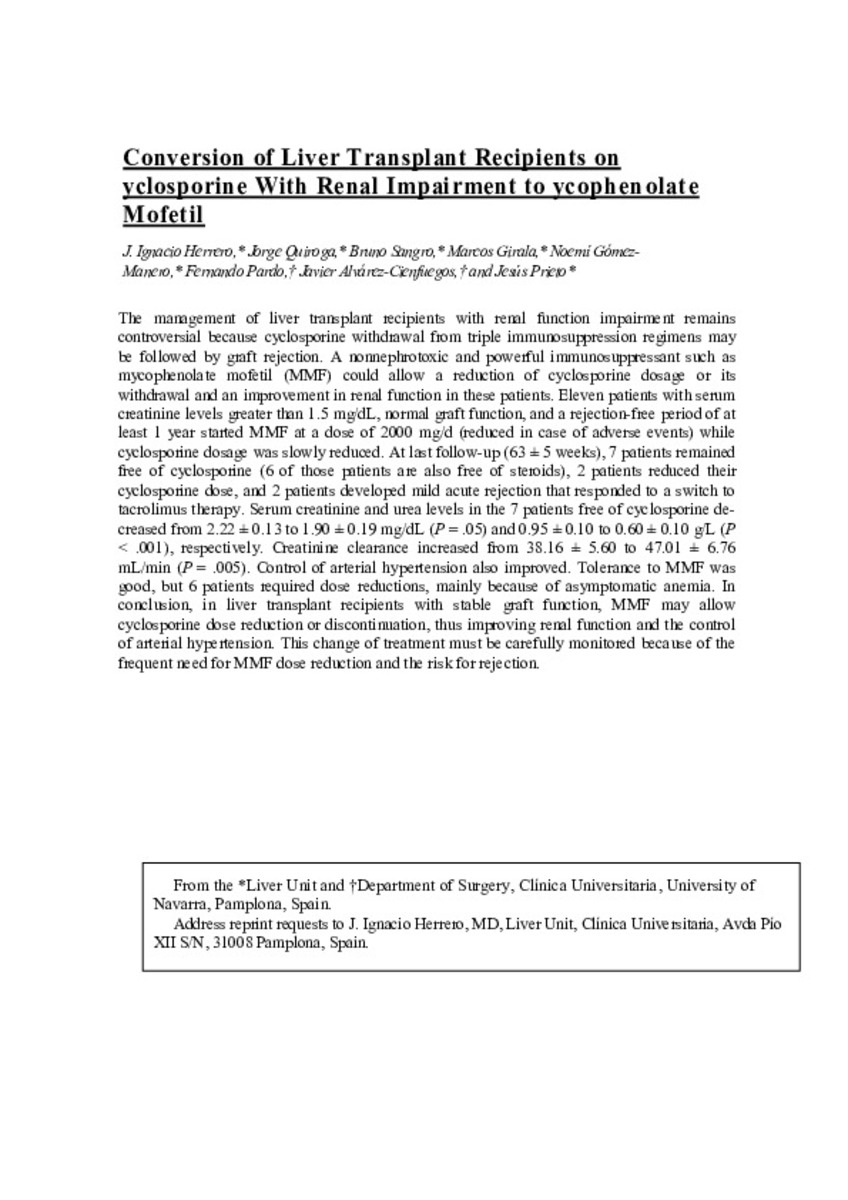Full metadata record
| DC Field | Value | Language |
|---|---|---|
| dc.creator | Herrero, J.I. (José Ignacio) | - |
| dc.creator | Quiroga, J. (Jorge) | - |
| dc.creator | Sangro, B. (Bruno) | - |
| dc.creator | Girala, M. (Marcos) | - |
| dc.creator | Gomez-Manero, N. (Noemí) | - |
| dc.creator | Pardo, F. (Fernando) | - |
| dc.creator | Álvarez-Cienfuegos, J. (Javier) | - |
| dc.date.accessioned | 2012-11-08T11:56:07Z | - |
| dc.date.available | 2012-11-08T11:56:07Z | - |
| dc.date.issued | 1999 | - |
| dc.identifier.citation | Herrero JI, Quiroga J, Sangro B, Girala M, Gomez-Manero N, Pardo F, et al. Conversion of liver transplant recipients on cyclosporine with renal impairment to mycophenolate mofetil. Liver Transpl Surg 1999 Sep;5(5):414-420. | es_ES |
| dc.identifier.issn | 1074-3022 | - |
| dc.identifier.uri | https://hdl.handle.net/10171/23668 | - |
| dc.description.abstract | The management of liver transplant recipients with renal function impairment remains controversial because cyclosporine withdrawal from triple immunosuppression regimens may be followed by graft rejection. A nonnephrotoxic and powerful immunosuppressant such as mycophenolate mofetil (MMF) could allow a reduction of cyclosporine dosage or its withdrawal and an improvement in renal function in these patients. Eleven patients with serum creatinine levels greater than 1.5 mg/dL, normal graft function, and a rejection-free period of at least 1 year started MMF at a dose of 2000 mg/d (reduced in case of adverse events) while cyclosporine dosage was slowly reduced. At last follow-up (63 6 5 weeks), 7 patients remained free of cyclosporine (6 of those patients are also free of steroids), 2 patients reduced their cyclosporine dose, and 2 patients developed mild acute rejection that responded to a switch to tacrolimus therapy. Serum creatinine and urea levels in the 7 patients free of cyclosporine decreased from 2.22 6 0.13 to 1.90 6 0.19 mg/dL (P 5 .05) and 0.95 6 0.10 to 0.60 6 0.10 g/L (P F .001), respectively. Creatinine clearance increased from 38.16 6 5.60 to 47.01 6 6.76 mL/min (P 5 .005). Control of arterial hypertension also improved. Tolerance to MMF was good, but 6 patients required dose reductions, mainly because of asymptomatic anemia. In conclusion, in liver transplant recipients with stable graft function, MMF may allow cyclosporine dose reduction or discontinuation, thus improving renal function and the control of arterial hypertension. This change of treatment must be carefully monitored because of the frequent need for MMF dose reduction and the risk for rejection. | es_ES |
| dc.language.iso | eng | es_ES |
| dc.publisher | Wiley-Blackwell | es_ES |
| dc.rights | info:eu-repo/semantics/openAccess | es_ES |
| dc.subject | Mycophenolic Acid/analogs & derivatives/therapeutic use | es_ES |
| dc.subject | Prednisone/therapeutic use | es_ES |
| dc.subject | Renal Insufficiency/blood/chemically induced | es_ES |
| dc.title | Conversion of liver transplant recipients on cyclosporine with renal impairment to mycophenolate mofetil | es_ES |
| dc.type | info:eu-repo/semantics/article | es_ES |
| dc.relation.publisherversion | http://onlinelibrary.wiley.com/doi/10.1002/lt.500050513/pdf | es_ES |
| dc.type.driver | info:eu-repo/semantics/article | es_ES |
Files in This Item:
Statistics and impact
Items in Dadun are protected by copyright, with all rights reserved, unless otherwise indicated.






